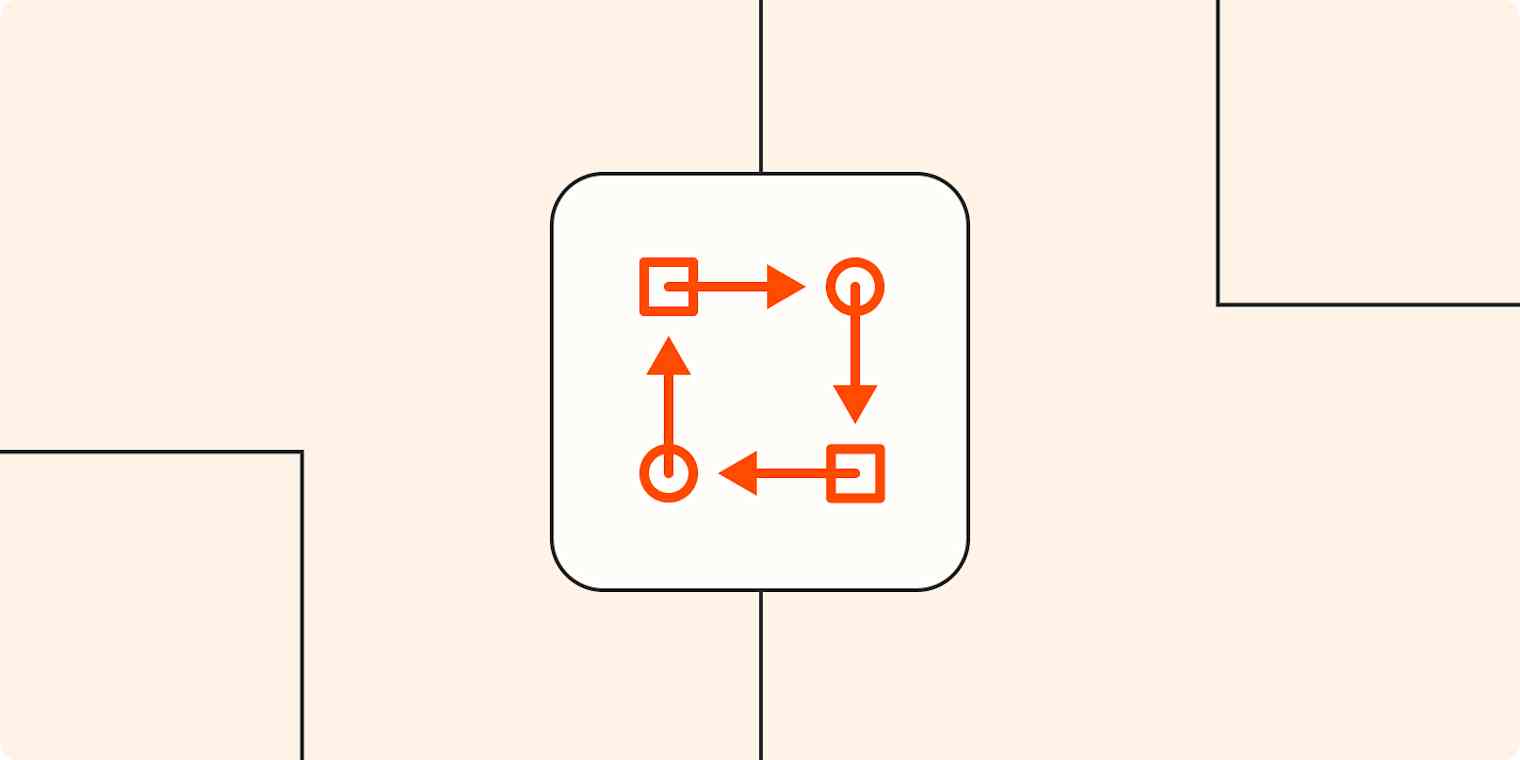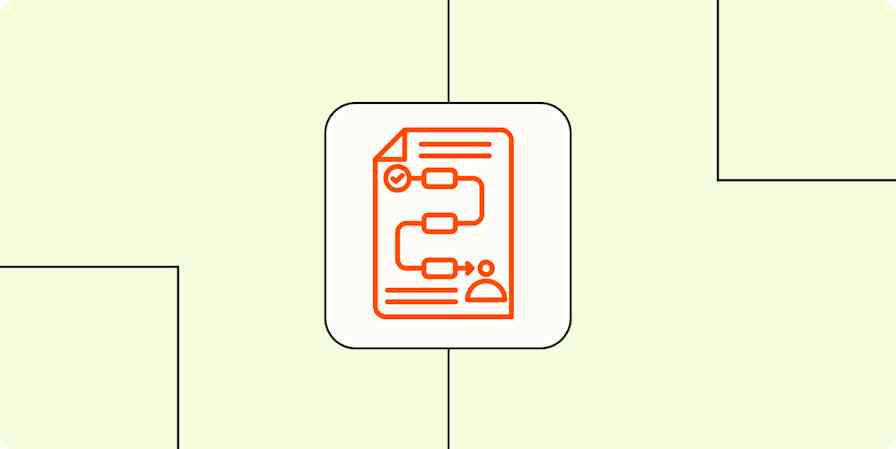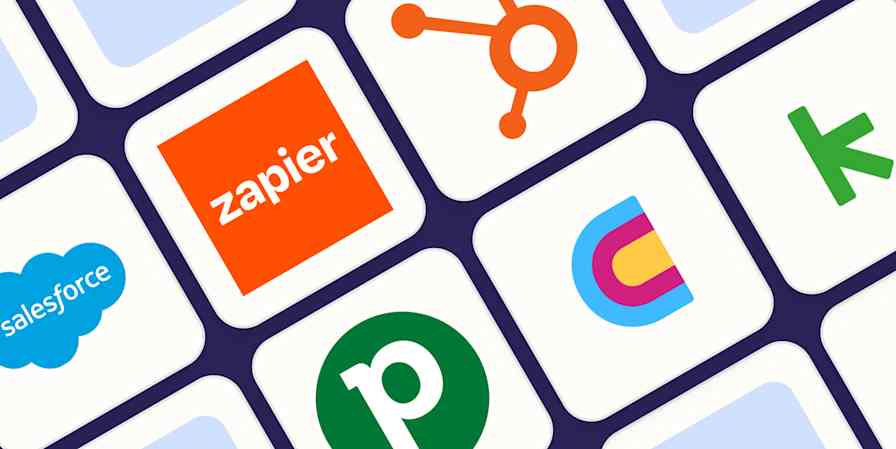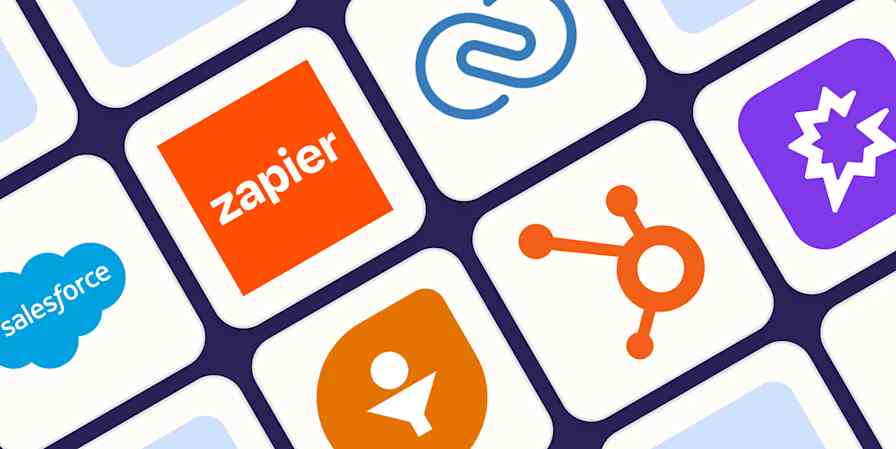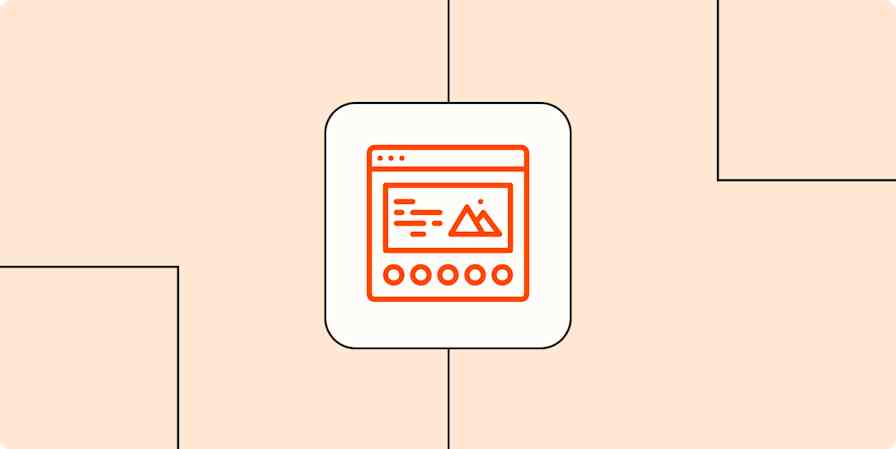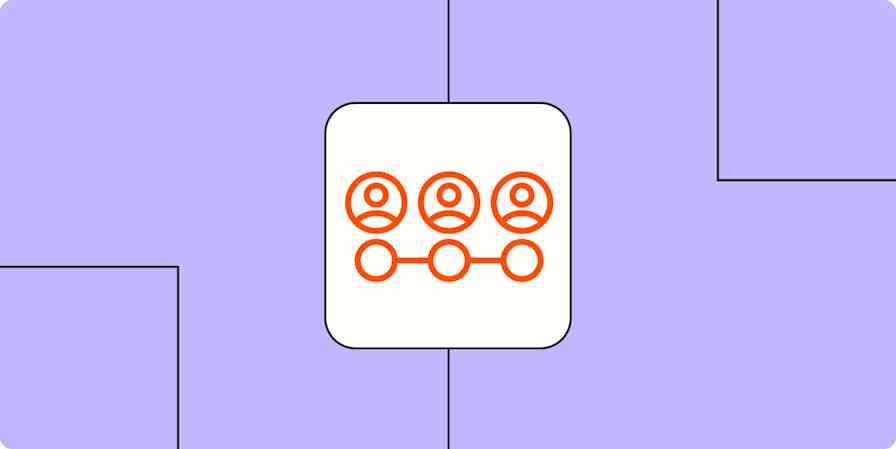Growing up, I had an upcycling business where my neighborhood friends and I went door to door for recyclables. We managed our inventory out of a garage and planned production for transforming junk into shiny new household items.
We anticipated demand by upping production on our most popular item: milk jugs turned watering cans. We strategized price points, charging less for the items we taped together with sticky notes after we ran out of actual tape.
Our sales and operations planning, or S&OP, was on point. It just so happens that nobody wants to buy their trash back from children.
While my childhood get-rich-quick scheme didn't turn into the thriving corporation I hoped for, I've since learned better ways to conduct sales and operations planning for businesses today.
Here's how you can leverage S&OP for increased efficiency and profitability that my childhood entrepreneurship never quite reached.
Table of contents:
What is S&OP?
Sales and operations planning, or S&OP, is a process that businesses use to ensure they have the right amount of inventory—not too much and not too little (which would cause them to miss out on potential sales).
The S&OP process is cyclical and is repeated either monthly or quarterly, depending on how far into the future the company is able to forecast. Companies whose products are always in demand and don't expire—like, say, alcohol—can afford to do their sales and operations planning less frequently. Seasonal, perishable, or highly trend-specific products require more careful sales and operations planning.
The S&OP cycle is ongoing and restarts at the end of every period, beginning with the collection of the past month's sales data and ending with an executive meeting where the company decides what its sales plan is for the coming period.
3 components of S&OP
The entire S&OP process relies on equal involvement of three key components: people, process, and technology. If any one of these components is missing or out of balance, the S&OP process falls apart.
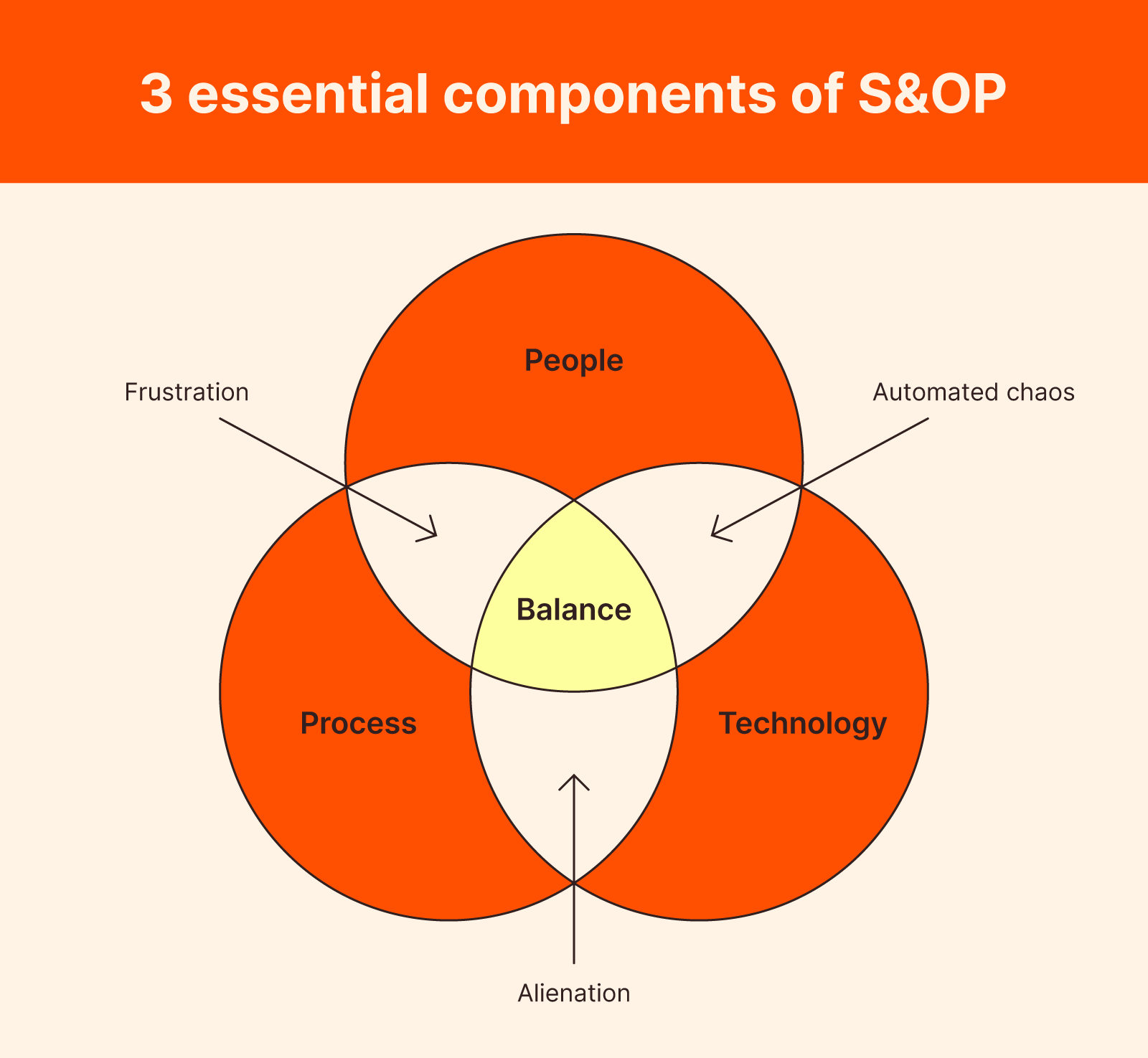
People
The pre-S&OP reconciliation process can feel a bit like herding cats. You reconciled the plan with finance last week, but this week's marketing meeting resulted in changes that make last week's sign-offs moot. Getting everything to line up perfectly can be so difficult that some teams are tempted to skip the process and just handle it themselves.
Here's the problem: you don't just need logistics buy-in. You need the support and approval of your department stakeholders in order to execute your S&OP plan well. When you don't involve your people in the process, you wind up with an alienated, disengaged workforce.
Process
The steps of the S&OP process aren't as cut and dry as your regular checklist of to-dos. The process is ongoing and repeats as soon as it's complete, and different phases can overlap as parts are delegated to different team members. With these semi-blurred lines separating your process steps, it's easy to lose your structure entirely, which will bring the whole operation down quickly.
A well-structured process is necessary to keep your S&OP cycle flowing smoothly. Automation can help with a lot of that, allowing you to offload repeatable tasks to technology and focus on the work that most requires your attention. But if you have people and technology without a process, you wind up with automated chaos. There's a reason that automations aren't designed to replace people—they require structured oversight to work effectively.
Technology
There are lots of things that are made easier by technology but would be perfectly doable without. The S&OP process is not one of those things. Unless you're running a very, very small operation, trying to do your S&OP by hand will be very frustrating.
Without technology, S&OP teams would have to collect and process data by hand, create forecasts manually, and personally implement their plans once they're approved by the executive team. With automated systems, you can collect data on an ongoing basis, generate reports with multiple views and time frames, set up implementation triggers, and communicate instantaneously with your team.
S&OP benefits
S&OP eliminates the "guess and hope for the best" approach from your business. While that's all good for a business run by a group of 11-year-olds, it leaves room for last-minute panic or surprise shortages. S&OP helps:
Increase profitability: When you align sales forecasts with production capabilities, you reduce excess inventory costs and minimize stockouts. Translation: more money in your pocket at the end of the day.
Shorten the planning process: Dragging your feet through a long planning process limits your business opportunities. By integrating data and communication, you can make decision-making quicker and respond faster to market changes.
Enhance cross-functional collaboration: S&OP (nicely) forces sales, production, and other cross-functional departments to break down silos and collaborate. As a result, you have better-informed decisions, optimal resource allocation, and a more agile response to customer demands.
Deliver on customer needs: Nobody wants to buy fuzzy sweaters after February. Synchronizing sales forecasts and production schedules helps ensure products are available when and where customers need them.
Improve production stability: Similarly, everybody hates when products are out of stock. S&OP balances inventory levels and production rates to reduce the impact of demand fluctuations.
Optimize production capacity: Alignment with anticipated demand helps avoid the over- or underutilization of resources, ensuring efficient production and savings. It's the ultimate satisfaction to use the exact amount of resources to produce what you need.
5 steps of the S&OP process
There are five different steps, or phases, to sales and operations planning. They are:
Demand planning
Supply planning
Pre-S&OP meeting
Executive meeting
Here we'll dive into each step in more detail and explain what goes on in every phase. For purposes of this explanation, I'm going to use the word "month," but the steps and process are the same no matter what time period you choose to work with.
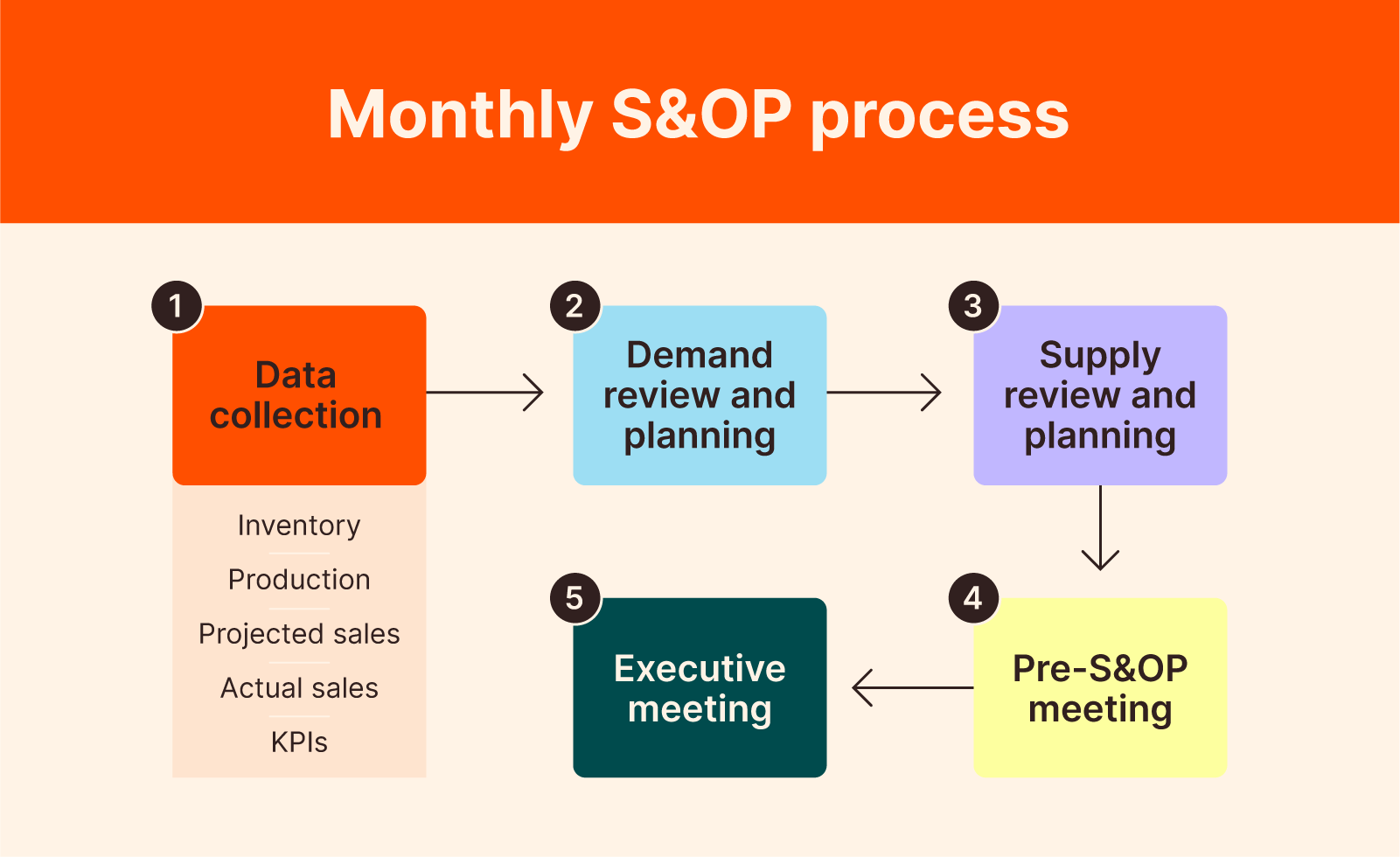
Step 1: Data collection
The first step in the S&OP process is to collect data from the prior month that can help you identify supply and demand patterns and plan production going forward. Key data to collect from the previous month includes:
Projected demand
Actual sales
Inventory produced
Production capacity
Events impacting demand (market shifts, price changes, or real-world events)
You'll also need to reference some of your standard financial information during this process, so you'll want to make sure you have the most recent and updated numbers for:
Production costs
Product price
Holding costs
Shipping/transportation costs
With this data in hand, you can move on to the next step: demand planning and review.
Step 2: Demand review
The next step in the process is to evaluate demand levels, both for the prior month and historically over time. During this review, you should look to answer these questions:
What did we predict that demand would be last month? Did actual demand sales reflect these predictions? If not, why?
Did demand fluctuate in ways we didn't anticipate? What caused these fluctuations?
How did last month's demand compare to demand for the same month last year and years prior? What patterns are consistent year-to-year?
What wider market trends are influencing our market sector right now? Are there global events at play that may impact demand?
The goal of a demand review is to use historical data to figure out what events, patterns, and trends are influencing sales. Then, you'll use that information to create a forecast predicting demand levels for the coming month.
Step 3: Supply planning
I say this is step three, but supply and demand planning can usually happen simultaneously. In this step, you'll repeat the same steps you used in the demand review but with a focus on the supply side. This time, you'll start with one main question: how much inventory did we produce last month to meet our predicted demand, and was it enough or too much?
The questions you ask from there will depend on whether you had a surplus or shortage of supply.
If you overproduced last month:
Why was supply higher than forecasted? Were there mistakes in last month's forecasting process?
How much unsold product is being stored in inventory?
Is your product perishable? What's the cost of your waste?
Are the products highly seasonal, or will there be demand for them in the coming month?
What are your holding costs? (In other words, how much does it cost you to store this inventory?) Does it make more financial sense to store it or sell it at a discount?
If you had a shortage last month:
Why did your supply forecast fall short of actual sales? Were there mistakes in last month's forecasting process?
Was the shortage caused by a shortage of materials needed to create your product? If so, is that shortage still in effect?
Do you have the necessary materials to produce enough goods to meet higher demand in the coming month?
What is the cost per unit of production? Are there materials or process changes you can make to lower your production costs?
You should also evaluate wider economic trends to determine whether there are external factors that could affect your ability to meet demand. For example, if you rely on commodities like oil, gas, wood, or water, you'll need to stay aware of environmental and political factors that could affect your supply chain.
Once your supply review is completed, you'll move onto supply planning. What this part of the process looks like will vary a lot depending on what kind of business you're in. Ultimately, you want to come up with different potential scenarios for the coming month and determine how best to meet demand while minimizing costs.
Step 4: Pre-S&OP—reconciliation of plans
After supply and demand planning are complete, you enter the "pre-S&OP" meeting stage. Depending on your business's size and process, this can be multiple meetings with different departments, or it can be one large gathering. The goal is to connect your supply and demand plans with all of the other departments in your company, like finance, product, customer service, and marketing.
Let's say your forecasts predict higher demand next month and, therefore, higher required supply. Different departments will be affected in different ways:
The finance department will have to draw up a plan to source more materials and divert higher profits to the appropriate departments.
Customer service will need to adjust schedules to ensure full coverage through peak sales times.
If you're having a sale to clear out out-of-season inventory, the marketing department will need to plan an ad push.
Every department of the company will be affected by supply and demand forecasts, and your supply and demand plans will be affected by every department in the company. Since the plan will continue to evolve as you reconcile it with each department, the most efficient way to manage pre-S&OP reconciliation is with a shared dashboard and centralized workflow plan. Set up automations to notify stakeholders when plans change, new information is needed, or another meeting is put on the books.
Step 5: Executive meeting—finalize S&OP
When your S&OP plan has been reconciled with and approved by each department, it moves on to the last step: the executive S&OP meeting. This is where the company's senior leaders come together to review the S&OP plan and make any necessary adjustments. The goal of this meeting is to ensure that the plan is realistic and aligns with the company's overall strategy.
As soon as the executive team signs off on the S&OP plan, the entire company can get to work putting it into action. This is another area where automation can be handy—each department leader can set up the first steps of their process to be triggered by the executive S&OP approval. For example, the marketing team might have a drip email campaign ready to go, or the sourcing and procurement department can trigger automatic RFP submissions. Since the S&OP process starts over as soon as the last cycle ends, workflow automation is key to ensuring nothing falls behind.
S&OP best practices
Selling people's trash back to them is hard. S&OP doesn't have to be. Here are some best practices to remember so S&OP can help your company.
1. Define metrics
You can put a plan in place, but it will only be useful if you follow up on its performance. Defining relevant key metrics will help guide your S&OP and make it easier to optimize it over time. Consider setting benchmarks for some of these supply and demand and sales metrics:
Demand forecast accuracy: Accuracy of predicted sales or demand compared to actual sales or customer orders
Inventory turnover: Number of times inventory is sold and replaced within a specific period, indicating inventory efficiency
Stockout rate: Percentage of times demand can't be met due to insufficient inventory
Lead time: Time it takes to fulfill an order, from placement to delivery
Working capital: Capital tied up in inventory, accounts receivable, and accounts payable
Forecast bias: Tendency of forecasts to consistently overestimate or underestimate actual demand
Cost of sales (COS): Direct costs associated with the production of goods sold
On-time delivery: Percentage of orders delivered on time as per the agreed-upon schedule
Capacity utilization: How efficiently production resources are being used to meet demand
2. Use up-to-date data
Timely data provides a real-time snapshot of market trends, customer demands, and supply chain performance. Armed with that kind of data, you can respond swiftly to changes, minimize risks, and jump on opportunities. To make this a reality, you're going to need:
Robust data management processes: A centralized data repository, data governance framework, data validation, and automated data integration ensure data is collected, processed, and stored efficiently and accurately so the most current information is available for S&OP.
An advanced analytics tool: Consider tools that have data-driven forecasting, scenario modeling, real-time reporting, and predictive analytics to enable in-depth data analysis.
Regular data updates: Set up automated processes to regularly refresh data, implement data monitoring mechanisms, or incorporate data update protocols within the data governance framework.
Relevant data, tools, and processes should be shared across departments so everyone in the S&OP process is working with the same information and protocols. This reduces data discrepancies and encourages these data processes to be solidified into your S&OP workflow.
3. Determine an internal owner
Apologies if the words "Who wants to own this?" send a shiver down your spine, but this project really needs a designated person in charge. Of course, the whole effort is about collaboration, but a single point of contact helps drive the process, facilitate communication across departments, and champion necessary changes.
The owner also acts as a project advocate by gaining buy-in from key stakeholders in meetings and regular updates. Here are a few tips to make this as painless as possible:
Choose the right candidate: Select someone who has strong leadership skills, understands the intricacies of S&OP, and has credibility across departments. Also review candidates' workloads and choose someone who has enough bandwidth or reprioritize their workload so the S&OP project doesn't end up on the backburner.
Define responsibilities: Meet with key stakeholders and clearly outline the internal owner's role, so they have the necessary authority to drive change and make decisions when required. Outline how other roles will support the owner, so they don't end up doing everything themselves.
Ensure support: Gain support from senior management to empower the internal owner with the necessary resources and authority. This may just look like execs letting go of responsibilities like daily approvals, running meetings, or delegating tasks.
4. Run through "what-if" scenarios
Simulating different scenarios can help you assess the impact of these changes on your operations and develop agile strategies to address challenges proactively. Here are a few example scenarios to chew on:
Supply chain disruptions: Analyze potential situations like delays in raw material deliveries, production interruptions, or supplier capacity constraints. What's the impact on production lead times and inventory levels?
Demand fluctuation scenarios: What about if customer demand varied significantly? Think about spikes in demand due to unexpected events like product recalls, viral social media campaigns, or economic downturns.
Regulatory changes: Evaluate scenarios where changes in regulations or trade policies affect import or export restrictions, tariffs, or compliance requirements.
Environmental factors: Run through possibilities like natural disasters or climate-related events that could disrupt supply chains, operations, or consumer behavior.
5. Find a workflow that fosters collaboration
Collaboration within S&OP ensures that various departments collaborate seamlessly to share insights and expertise. Find a workflow that helps, not hinders, this collaborative experience. Consider the following tips:
Establish clear objectives: Gather feedback from key stakeholders to identify and define shared objectives. Once you have a unified goal, share it with the larger team in a centralized location so every contributor can see how they add to the big picture.
Involve key stakeholders early: Getting main players involved from the get-go helps them know their opinions matter, which makes them want to buy in and commit to the process.
Implement collaborative tools: Leverage those Slack channels or S&OP software that facilitate communication, document sharing, real-time updates, and the occasional GIF or two.
Recognize and celebrate success: It's easier to rally around a cause when you can see (and are acknowledged for) the results of your hard work. Make a point to celebrate the achievements of cross-functional teams to boost morale and reinforce teamwork.
How to choose S&OP software
In theory, you could manage S&OP with a patchwork of other apps and platforms to handle different parts of the process. In reality: that way lies frustration and disaster. This is one area where, unless you're running a small operation, a purpose-built S&OP platform really is necessary.
There are lots of S&OP platforms out there, like SAP, Oracle, Vanguard, Logility, and Atlas. Each platform offers different features, but all S&OP software will include some basic capabilities:
KPI tracking
Reports and analysis
Collaborative planning tools
Forecast calculations
Scenario planning
You might be able to handle collaboration via your project management tool or track sales and inventory with a spreadsheet (up to a point), but an S&OP platform works cross-functionally so that all of these processes are managed in one place. When you update a figure—say, a warehouse floods and 10% of your inventory is lost—your entire S&OP process, from data reports and to scenario forecasts, will update automatically.
When choosing an S&OP platform, pay attention to app integrations and compatibility. You'll want your software to be able to do things like pull sales and inventory data from your CRM, send pricing updates to your accounting system, and notify your team with updates. The more of your S&OP process you can automate, the more time you'll have to connect with your team, make complex operations decisions, and stay ahead of any supply and demand curveballs headed your way.
Related reading:
This article was originally published in July 2022 by Amanda Pell. The most recent update was in August 2023.
